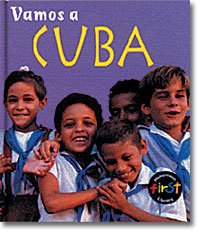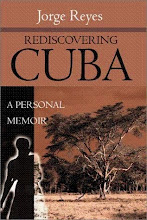“Vamos a Cuba” ! and, what's wrong with that?

by Jorge Reyes
I’m often more perplexed, and disappointed, not to mention angry, every time I see the foolishness of my own community: the so-called Cuban exiled community in Miami.
Not too long ago the Miami-Dade county banned from the school’s library system a book which, had it not been for its controversial banning, would have perished unread and unopened in those perennial dust-bin which most books seem fated to in our public library system.
According to those who know better, the book, which was written for children 10-15, gives a too-cheery positive outlook to the educational, cultural and health care systems to the post 1959 communist-based Cuban government.
To quote "School Library Journal,"
"Grade 2-4-Colorful photographs and brief texts fill the pages of these introductory titles. The table of contents is essentially identical for both: land, landmarks, homes, food, clothes, work, transportation, language, school, free time, celebrations, and the arts. Each topic is covered in a two-page spread with one large photograph and three or four lines of simple text per page. (For example, "Cruise ships stop at San Juan. They bring tourists to the islands," is followed by four more sentences about transportation in Puerto Rico.) Words in bold are explained in the glossary. A "Fact File" is found at the end of each volume along with identical lists of "Words You Can Learn," in Spanish. These books are similar in scope and reading level to the "Take a Trip" series (Watts), but provide fewer details. While the information is very basic and succeeds in giving only a glimpse at life in these countries, the books may be appropriate for collections needing easy titles on different nations."
Marilyn Long Graham, Lee County Library System, Estero, FL
Copyright 2001 Reed Business Information, Inc.
Immediately, the book was slated for a vote to get it out of children’s hands and, God willing, out of the many ways that an open society should debate controversial issues when opposing points of views seem to be of conflict. Of course, never mind that controversial issues are hardly ever addressed by anyone since most of what we end up hearing are blaring sound-bytes written for the evening news, not substantial debates of the issues. Of course, never mind that in this country those of a left political leniency—from social democrats to outright communists—have as much of a constitutional protection to express, teach their kids and, yes, even proselytize as those of a right-wing leniency—from Christian fundamentalists to Libertarians.
A vote was held a few months later and to no one’s surprise, the book was voted out of our endearing children’s hands.
This sends a chill down my spine. Cubans, the community I am a part of, should know better and, honestly, ought to be ashamed. This is more alarming since we are a community that fled our native country in order to escape a political dictatorship, not to mention a monopoly of ideas.
The same motivating factor that pushes us to ban materials which is not to our liking is the same one that compels someone like Castro to send children and young adults to prison for ten, twenty, thirty years in prison simply because those same children dare to have an opinion which differs from the majority’s opinion. In the case of Cuba, Fidel's own opinion.
Again, thank God that this latest travail into my right to read and learn everything I want short of hurting anyone else, will see its day in court. I hope that judges at any level are more interested in protecting First Amendment rights than narrow political allegiances. We, as a society, gain far more by agreeing to disagree than by creating a society of robots where everyone things the same.
All of which brings me to this: yes, vamos a Cuba! Let’s visit Cuba. End this foolish farcical sideshow called the embargo. Let’s end once and for all type of embargos and let’s start by believing in something very few of us truly know what to do with: freedom.




